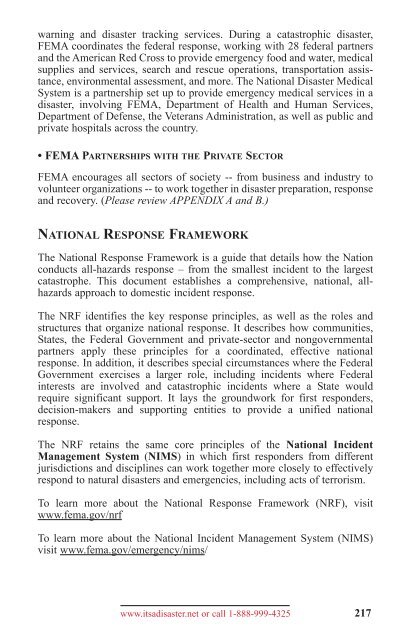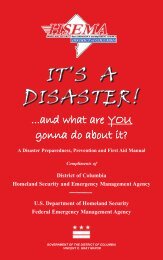disaster 5th 1108_5th ed 2011 - Homeland Security and Emergency ...
disaster 5th 1108_5th ed 2011 - Homeland Security and Emergency ...
disaster 5th 1108_5th ed 2011 - Homeland Security and Emergency ...
You also want an ePaper? Increase the reach of your titles
YUMPU automatically turns print PDFs into web optimized ePapers that Google loves.
warning <strong>and</strong> <strong>disaster</strong> tracking services. During a catastrophic <strong>disaster</strong>,<br />
FEMA coordinates the f<strong>ed</strong>eral response, working with 28 f<strong>ed</strong>eral partners<br />
<strong>and</strong> the American R<strong>ed</strong> Cross to provide emergency food <strong>and</strong> water, m<strong>ed</strong>ical<br />
supplies <strong>and</strong> services, search <strong>and</strong> rescue operations, transportation assistance,<br />
environmental assessment, <strong>and</strong> more. The National Disaster M<strong>ed</strong>ical<br />
System is a partnership set up to provide emergency m<strong>ed</strong>ical services in a<br />
<strong>disaster</strong>, involving FEMA, Department of Health <strong>and</strong> Human Services,<br />
Department of Defense, the Veterans Administration, as well as public <strong>and</strong><br />
private hospitals across the country.<br />
• FEMA PARTNERSHIPS WITH THE PRIVATE SECTOR<br />
FEMA encourages all sectors of society -- from business <strong>and</strong> industry to<br />
volunteer organizations -- to work together in <strong>disaster</strong> preparation, response<br />
<strong>and</strong> recovery. (Please review APPENDIX A <strong>and</strong> B.)<br />
NATIONAL RESPONSE FRAMEWORK<br />
The National Response Framework is a guide that details how the Nation<br />
conducts all-hazards response – from the smallest incident to the largest<br />
catastrophe. This document establishes a comprehensive, national, allhazards<br />
approach to domestic incident response.<br />
The NRF identifies the key response principles, as well as the roles <strong>and</strong><br />
structures that organize national response. It describes how communities,<br />
States, the F<strong>ed</strong>eral Government <strong>and</strong> private-sector <strong>and</strong> nongovernmental<br />
partners apply these principles for a coordinat<strong>ed</strong>, effective national<br />
response. In addition, it describes special circumstances where the F<strong>ed</strong>eral<br />
Government exercises a larger role, including incidents where F<strong>ed</strong>eral<br />
interests are involv<strong>ed</strong> <strong>and</strong> catastrophic incidents where a State would<br />
require significant support. It lays the groundwork for first responders,<br />
decision-makers <strong>and</strong> supporting entities to provide a unifi<strong>ed</strong> national<br />
response.<br />
The NRF retains the same core principles of the National Incident<br />
Management System (NIMS) in which first responders from different<br />
jurisdictions <strong>and</strong> disciplines can work together more closely to effectively<br />
respond to natural <strong>disaster</strong>s <strong>and</strong> emergencies, including acts of terrorism.<br />
To learn more about the National Response Framework (NRF), visit<br />
www.fema.gov/nrf<br />
To learn more about the National Incident Management System (NIMS)<br />
visit www.fema.gov/emergency/nims/<br />
www.itsa<strong>disaster</strong>.net or call 1-888-999-4325<br />
217





